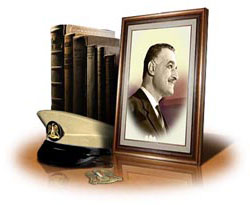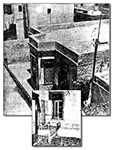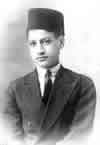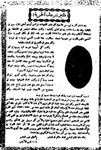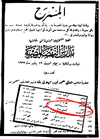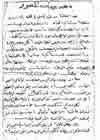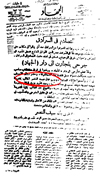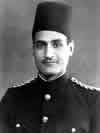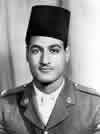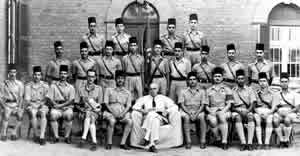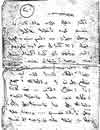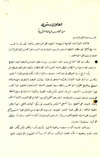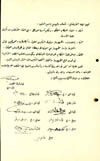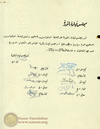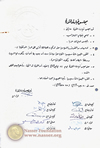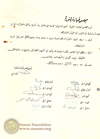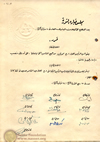Gamal Abdel-Nasser was born on the 15 January 1918, at 18 Qanawat Street in Bacchus, a suburban district in Alexandria. He was the eldest son of Abdel-Nasser Hussein who was born in 1888 in Beni Murr village in Upper Egypt. Even though he descended from a poor family of villagers, he still managed to obtain a sufficient amount of education to enable him to join the Postal Service in Alexandria but with his salary hardly maintaining his basic requirements.
Elementary Education:Nasser joined the nursery school of Muharram Bek in Alexandria then moved to Khatatba where he attended an elementary school (1923-1924). In 1925, he moved to Cairo where he stayed with his paternal uncle, Khalil Hussein for three years in his humble dwelling in a suburban Cairo district. There he joined El-Nahassin Elementary School in Gamalia. On weekends, Gamal used to travel to Khatatba to visit his family. On one of his visits in 1926, during the summer vacation, he learned of the death of his mother to whom he was greatly attached. No one had enough courage to inform him, leaving him to make the tragic discovery on his own—something which left a deep wound in his soul as he later reminisced to David Morgan, the Sunday Times reporter: "… My mother’s death was a tragic event in itself, but losing her this way was a shock so deep that time failed to remedy … The pain and sorrow I felt back then made me think twice before hurting anyone ever since …" After completing his third year at El-Nahassin School, his father sent him to Alexandria in the summer of 1928 to stay with his maternal grandfather where he spent his fourth year of elementary school at El-Attarin School.
Secondary Education:
In 1929, Gamal Abdel-Nasser he entered the boarding house of the Helwan High School where he stayed for one year. The following year, he moved to Ras El-Tin High School after his father joined the Postal Service in Alexandria. It was at that school that Nasser’s national sentiment was shaped. In 1930, the Ministry of Ismail Sidky issued a decree pertaining to the cancellation of the 1923 constitution. This fueled student demonstrations calling for the fall of colonialism and the re-institution of the constitution. Nasser recounts the first demonstration in which he participated: “ While crossing the Manshiya Square in Alexandria, I noticed clashes between some demonstrating students and the police, I did not hesitate: I immediately joined the demonstrators not knowing anything about the cause of demonstration for I found no reason to ask. At the beginning it seemed that the demonstrators had the upper hand, but soon the police forces were backed with two trucks stuffed with policemen, turning the tables once more. I remember attempting to throw some stones but was immediately caught and, on trying to escape, I was struck by a blow on the head by a police baton followed by another blow until I fell down. All drenched in blood, I was driven to prison along with a group of students who failed to escape. It was at the police station, while receiving treatment for my head injuries, that I learned that the demonstration was an anti-government protest led by the "Masr El-Fatah" (Young Egypt) society. I went to jail filled with zeal and came out fuming with anger (Interview with Sunday Times correspondent David Morgan, 18 June 1962). "When I started talking today", Nasser reminisced in his speech at Alexandria's Manshiya Square on 26 October 1954, describing his feelings at that demonstration and its impact on him, "As I began to speak today in Manshiya Square, I went back to the remote past when I was young and remembered Alexandria's struggle, when I called out for freedom and dignity in the name of Egypt for the first time in my life. We were shot at by the bullets of colonialism and its agents: some died, some were wounded; but among them emerged a young man who enjoyed the sense of freedom and promised himself to fight for the freedom he so fervently called for without truly knowing its meaning for he felt it deep inside, echoing in his soul, running in his blood." The period Nasser spent in Alexandria represented a turning point in his life as it made him grow from a mere protestor into an ardent rebel influenced by the state-wide agitation against colonialism and the annulment of the Constitution. Nasser's school officials, deeply concerned over his political activities, warned his father who in turn sent Nasser to Cairo.
In 1933, Nasser joined El-Nahda Secondary school at El-Zaher district in Cairo where he pursued his political career and became head of El-Nahda schools student union. During that time, his passion for reading on patriotic and history-related literature led him to read about the French Revolution, Rousseau, Voltaire, Napoleon Bonaparte, Alexander the Great, Julius Caesar, and Gandhi. He even wrote an article entitled “Voltaire, the Man of Freedom” which was published in the school magazine. He also read Les Misérables by Victor Hugo, A Tale of Two Cities by Charles Dickens. (Books read by Nasser during high school) Nasser was also interested in Arab literature, especially the works of Ahmed Shawki and Hafez Ibrahim; he read about the life of the Prophet Muhammad (Peace Be Upon Him) and great Muslim figures, as well as the great Egyptian political leader Moustafa Kamel. He also read novels and plays by Tawfik Al-Hakim, especially his ‘Awdat El-Rouh (Restoration of the Spirit) which is about the emergence of an Egyptian leader who will unite Egyptians and promote them to fight for their freedom and for the revival of the national spirit.
In 1935, he played the role of Julius Caesar at the school’s annual party which was attended by the Minister of Education. The year 1935 also witnessed a great revolutionary student-led movement calling for the re-installation of the constitution and for independence. In his letter to his friend Hassan El-Nashar, Nasser reveals: “We have moved from the light of hope to the darkness of despair, shaken off the glad tidings of life and faced death. Where is the man who will change all that and take Egypt back to the days of glory when it ruled the world? Who can bring up a new generation capable of standing up for their rights instead of sullenly accepting their fate, never fighting oppression? Moustafa Kamel said, “If my heart were to move from left to right, or the pyramids were to change their place, or the Nile were to change its course, I would never abandon my principles.’ This is but a long prelude to an even longer struggle; we have frequently spoken of a great action that would bring a dramatic change to the nation and awaken it from its slumber, however, nothing has been done yet.” (from a letter from Nasser to Hassan El-Nashar, 4 September 1935).
Two months later, on 9 November 1935, after British Foreign Minister, Samuel Hoare declared Britain’s refusal to re-install the Egyptian constitution, several student and worker demonstrations broke out. On 13 November Nasser led a demonstration by secondary school students in which he sustained injuries to his forehead from a shot by the British police forces. He was rushed by his colleagues to the nearby Al-Gihad publishing house. Nasser’s wound was superficial, but it won him mention in the following morning’s edition of the nationalistic newspaper Al-Gihad. (Al-Gihad, 1935). He later recounts these events in a speech at Cairo University on 15 November 1952: “ … that scar will always remain a mark of honor reminding me of my national duty. That day a great number of nationalists, including Abdel-Meguid Morsy, were assassinated and this increased my resilience to free the nation.” On 12 December 1935, and under public pressure, a royal decree was issued to re-install the 1923 constitution. Nasser joined the students who approached leaders’ in their homes urging them to unite for the sake of Egypt. These efforts fruited in the establishment of the Egyptian Nationalist Movement in 1936.
In a letter to Hassan El-Nashar on 2 September 1935, Nasser wrote: “Allah the Almighty said: [And prepare against them whatever you are able of power]. So, where is that power? It is a critical situation and Egypt is facing grave circumstances ...” In his The Philosophy of the Revolution, Nasser described his feelings: “in those days, I led a demonstration at El-Nahda School, and screamed from the bottom of my heart asking for complete independence, the crowds repeated after me. But our screams where in vain, for they were drowned by the wind which turned them into faint echoes that cannot move mountains nor break rocks…” The unanimous agreement among politicians came as a shock to Nasser as he reveals in his book. They agreed on the 1936 Treaty which gave legal plausibility to the occupation, as it maintained that some military bases should remain in Egypt to protect the Nile Valley and the Suez Canal against potential transgressions. According to the Treaty, and in the case that a war should evolve, the whole of Egypt including its ports, airways, roads would be under British disposal. The treaty also affirmed that occupant forces should remain in Sudan. This led the enthusiastic nationalist to double his political activity which led to his expulsion from El-Nahda School. However, the principal was forced to go back on that decision after the students went on a strike and threatened to set fire to the school. Since the first demonstration he ever joined, back in Alexandria, Nasser became occupied with politics. He moved from one political group to another including Young Egypt (for two years) which he left after having proven futile. He also had contacts with the Muslim Brotherhood, but finally decided not to join any of those groups and parties because he was not convinced of the utility of any of them. Driven by his Pan-Arab sentiments, Nasser used to go on protests with his peers at high school every year on the second of November rejecting Balfour’s promise of a home for the Jews in Palestine at the expense of its legitimate owners. Military Career:
After completing his secondary education and receiving his baccalaureat, literary section, Nasser decided to join the army. Following his experience with politics and his contact with politicians and political groups whom he despised, Nasser realized that Egypt will not regain its freedom by rhetorical speeches. He believed that force must be faced with force, and military occupation with a national army. He applied to the Military Academy and passed the medical examination but failed in the interview because of belonging to a poor family—his grandfather being a peasant from Beni Murr and his father a simple civil servant, participating in the 1935 demonstrations, and having no wasta (connections). After being rejected by the Military Academy, Nasser joined the Faculty of Law, Cairo University, in October 1936 for six months until the 1936 Treaty was formed, which increased the demand for officers regardless of their social rank or wealth. As a result, the Military Academy accepted a group of students in the fall of 1936. In March 1937, the Military Academy announced its need for another batch. Nasser managed to see General Ibrahim Khairy, Under-secretary of the Ministry of War who admired Nasser’s openness, nationalist spirit and insistence on becoming an army officer, so that he supported Nasser’s second attempt into the Military Academy. Once in the Military Academy, Nasser had a clear vision: “to become a qualified officer and to acquire the necessary knowledge and experience to enable him to become a leader”- which he did, becoming ‘lieutenant general’ with the task of training new officers , among whom was Abdel-Hakim Amer. During his college years he did not receive any penalties and was promoted to the rank of ‘ombashi’ (corporal).
Nasser graduated in July 1938 after spending only 17 months in the Academy owing to an increased demand for officers to fill the gap created by the mobilization of the British forces to the Suez Canal area. The library of the Military Academy was full of valuable books. Circulation records have shown that Nasser read about renowned historical figures such as Bonaparte, Alexander, Galibardi, Bismarck, Moustafa Kamal Ataturk, Hindenburg, Churchill, and Foch. He also read books about the Middle East, Sudan, the 1919 Revolution, Mediterranean concerns in addition to military history including World War I and the Palestine Campaign.(Books read by Nasser in the Military Academy). Following his graduation, Nasser joined the infantry and was transported to Minkabad in Upper Egypt where he had the opportunity to become closer to the peasants and their misery. It was also there that he met Zakariya Mohie-Eldin and Anwar El-Sadat. In 1939, upon his request to move to Sudan, Nasser served in Khartoum and in Jabal Awliya’ where he met Zakaryia Mohie-Eldin and Abdel Hakim Amer. In May 1940, he was promoted to first class lieutenant.
At that time the Egyptian army was a non-combatant one—a status which the British forces strove to maintain. However, a new group of officers with a new vision joined the army. They considered their role in the army a step towards the bigger mission of freeing the nation.
Nasser brought his ideals with him to Minkabad, but was disappointed to find that most of the officers there were “corrupt and inefficient”. This made him think of reforming the army. In 1941, he sent a letter from Jabal Awliya’ to his friend Hassan El-Nashar: “… anyways Hassan, I really don’t know how to face all those problems: here where I work I’m always accused of being straight-forward, not used to decorative speech and fancy words or licking people’s boots! Someone with these traits should be respected by everyone but our superiors love those who will sing their praises, and despise anyone who will not glorify them! They were brought up on humiliation under the occupation, and they want us to follow their footsteps— and woe to those who refuse to do so! I am sorry to say that the new generation has been spoilt by the old one! I am also sorry to say, Hassan, that we are descending into an abyss surrounded by hypocrisy and double-dealing. As for me, I will adhere to my principles, no matter what—that is why I’m always at odds with those superiors…” (Nasser’s letter to Hassan El-Nashar, 1941; published for the first time). By the end of 1941 while Rommel was progressing towards the western Egyptian territory, Nasser returned to Egypt where he was assigned to a British battalion close to the frontier near Alamein. He recollects: “At that time the thought of revolution became deeply embedded in my mind, however, the way to accomplish it was still obscure. I was mainly concerned with gathering a number of young, enthusiastic officers who aspired to free the nation. With this intention we could all serve this cause.” On 4 February 1942, during Nasser’s service in Alamein, the British ambassador Sir Miles Lampson surrounded the Abdeen Palace in Cairo with tanks. Lampson submitted an ultimatum to King Farouk to pressure the monarch—under threat of forced abdication—into assigning a pro-Britain government led by Moustafa El-Nahas. The king immediately submitted with no objections. Nasser recounts that nothing stayed the same since that day. On 16 February 1942, he wrote to Hassan El-Nashar: “ I received your letter which made my blood boil! But what can we do when we have so weakly surrendered after that shameful event. Actually, I think the British were only trying to intimidate us, but if they had felt that some Egyptians were willing to fight and sacrifice, they would have withdrawn like a whore. As for the army, this event had a great impact on the officers who started talking about sacrifice and dignity instead of women and amusement. They were filled with remorse because they had not taken action nor sacrificed their blood for the nation. Some tried to take action aiming to revenge, but it was too late! Anyhow, this blow managed to awaken the slumbering spirit within some bodies and taught them that there was a national dignity they had to fight for. It was a lesson—but a hard one!” (Nasser’s letter to El-Nashar, 16 February 1942).
On 9 September 1942, Nasser was promoted to the rank of yuzbashi (or Captain) and on 7 February 1943 he was appointed as an instructor at the Military Academy. During that time he read books by great military writers such as Liddel-Hart, Clausewitz, and political writers such as Cromwell and Churchill. He was also preparing to join the College of Corps Commanders and Chiefs of Staff. On 29 June 1944, Nasser married Tahiyya Mohammed Kazim, daughter of an Iranian merchant. Nasser was introduced to her family through his paternal uncle, Khalil Hussein. Nasser and Tahiyya had two daughters and three sons: Hoda, Mona, Khalid, Abdel-Hamid, and Abdel-Hakim. Tahiyya played an influential role in his life specially during preparations for the revolution and the formation of the Free Officers Movement. She took full responsibility of their small family—at the time composed of Hoda and Mona—when he was fighting in the Palestine War. She also helped him hide weapons when he was training Egyptian commandos to fight against the British military base in the Suez Canal in 1951 and 1952. Free Officers Movement:The year 1945 marked the end of World War II and the beginning of the Free Officers Movement. In his interview with David Morgan, Nasser says, “…until 1948, I focused on gathering people who were as distressed with the current situation in Egypt as I was, and who had enough courage and perseverance to make the necessary change. At that time we were a small group of faithful friends trying to execute our ideals to serve a common goal.” Following the decision in September 1947 to divide Palestine, the Free Officers met and decided that it was time to defend the Arabs and support the opposition in Palestine. The following day, Nasser met the Palestinian mufti who was a refugee living in Egypt, and proposed to train the opposition forces and to fight with them. The mufti declined the offer, saying he could not accept it without the approval of the Egyptian government; but they also refused. As a result, Nasser applied for leave so he could join the opposition. However, before any decision was taken, the Egyptian government officially asked the army to participate in the war. Accordingly, Nasser left to Palestine on May 16, 1948 after being promoted to major. The Palestinian war left an impact on Nasser, who said, “…there was lack of organization between the Arab forces, commandment was almost nil; even the weapons were mostly corrupt. Not just that, but in the middle of the battle, the engineering weaponry was asked to build a chalet for King Farouk in Gaza! It seemed that the Higher Commandment was concerned with occupying the largest possible area irrespectible of its strategic value and whether it would influence our chances of winning the battle. I was extremely annoyed with those officers who had no idea about fighting and battlefields but merely conducted the war from their offices. The final straw that broke the camel’s back was when I was commanded to head a battalion from the sixth infantry heading to Iraq Swaidan which was being attacked by Israel: to my surprise, I found details of our movements published in Cairo newspapers even before we took off! The Faluga was then besieged, an event I personally witnessed and saw how the Egyptian forces continued to resist the Israeli occupants even though they greatly exceeded them in number. The battle ended on February 24, 1949 as a consequence to the truce imposed by the United Nations.” Nasser was injured twice during the Palestine war and transported to the hospital. He was also awarded the ‘ Military Star’ medal owing to his distinguished role during the war in 1949. Upon his return to Egypt, Nasser realized that the real battle was there- for he found out that during the time he was fighting in Palestine, the politicians were busy heaping up profits of the corrupt weapons they cheaply bought then sold to the army. He was convinced that it was necessary to concentrate his efforts on attacking Mohammed Ali’s family, so king Farouk became the reason behind organizing the Free Officer’s Movement from 1948 to 1952. It was Nasser’s intention to carry out the revolution in 1955, however, contemporary events obliged him to act a long time before that. After his return from Palestine, on May 12, 1948 Nasser was appointed as a lecturer in ‘Arkan Harb’ College where he passed the exams with honors. He then resumed the Free Officers activities composing a panel headed by him and including Kamal Eldin Hussein, Abdel Hakim Amer, Hussein Ibrahim, Salah Salem, Abdel Latif Al-Bughdadi, Khalid Mohy Eldin, Anwar Elsadat, Hussein Alshafii, Zakariya Mohy Eldin, and Gamal Salem. This is the same panel that later became the Security Council in 1950, 1951. On May 8, 1951, Nasser was advanced to the rank of Major. It was also during the same year that he secretly organized, along with the Free Officers, the commandos’ war against the British forces in the Suez Canal region, which lasted until the beginning of 1952, in which he used to train volunteers and import weapons. Following the violent events that took place in the beginning of 1952, the Free Officers started thinking of assassinating leaders from the old political system as a solution to the current situation. They stared with General Hussein Serri Amer, one of the officers involved in serving the royal palace. However, their efforts failed and he escaped death. That was the first and last time for Nasser to become involved in such attempts and the Free Officers all decided to revert to other more positive approaches to attain radical changes. With the recruitment for the revolution, the Free Officers started secretly circulating some brochures which called for re-organization of the army, supplying it with appropriate weapons and training instead of squandering on parades and parties. It also called the leaders to stop wasting the nation’s wealth and to raise the standard of living of the poor. During that time the scandal of the corrupt weapons started spreading, along with other economic scandals in which the wafd parliament was involved. On January 26, 1952, protestors set fire to Cairo as a response to the massacre of police officers by British forces that took place in Ismailia in which 46 officers were killed and 72 wounded. The fire evolved but the authorities did not take any action except in the evening after the fire had destroyed 400 buildings- leaving 12 thousand people homeless, with total losses reaching 22 million pounds. At that time, a great strife- known as ‘the crisis of military officers’ club elections’- took place between the Free Officers and King Farouk after he nominated General Serri Amer, who was despised by the officers, to head the executive committee of the club. The Free Officers decided to submit their nominations which were headed by General Mohammed Naguib who was elected as president by the majority despite the fact that the elections were cancelled by the king. However, after realizing that they were supported by the army, Nasser decided to advance the time of the revolution which was supposed to take place in 1955. Accordingly, the army started moving on the night of July 23, 1952 occupying the building of High Commandment in Kubri Alkuba, and arresting the leaders who were discussing how to deal with the Free Officers. Following their success, Mohammed Naguib started heading the revolution after Nasser abandoned the position on August 25, 1952. Statement of the Revolution:“ Egypt has recently been going through a period marked by corruption, bribery, and governmental instability. All these left their impact on the army and led to our defeat in Palestine. Following the war, with coalition of the sources of corruption, traitors were conspiring against the army and assigning corrupt or ignorant leaders hoping that Egypt would remain without a defensive army. In view of that, after purifying our souls, we started appointing men whose abilities, manners and nationalism we trust- something that should be highly revered by all Egyptians. As for the officers who are currently held in custody, I assure you that they are safe, no harm shall afflict them and they will be released at the right time. I assure all Egyptians that the whole army is now acting in favor of our homeland guided by our constitution and not motivated by self-interests. I also take this opportunity to request all citizens not to allow any traitors to resort to violence or vandalism- for this will not be in the best interests of the nation. Any action of the sort will be met with unprecedented penalty, and the traitor will be severely punished by both the police and the army. Finally, I assure all foreigners that the army is fully responsible for their safety and well-being. May God grant us success.” On the 26th of July, three days following the Revolution, King Farouk was forced to exile after abdicating the throne to his son Ahmad Fuad. The following day Nasser was re-elected as President of the Free Officers Movement. On 18 June, 1953 an issue was decreed by the Revolutionary Council whereby the constitutional monarchy was cancelled and Egypt was announced a Republic with Mohammed Naguib as President- in addition to his position as Prime Minister which was held by him from 7 September, 1952. Nasser was appointed as Vice Prime-Minister and Minister of Interior Affairs. One month later, however, he renounced the latter position which was taken over by Zakaryia Mohei- Eldin. (Council Statement to cancel the monarchy).
Nasser as Chairman of the Revolution Command CouncilIn February, 1954 Mohammed Naguib resigned after having several disputes with the members of the Revolutionary Council. Nasser was nominated as Chairman of the Revolution Command Council and as Prime-Minister. The following is the Council Statement for the reasons behind the dispute which took place on 25 February, 1954: “ My fellow citizens “ it was never the aim of the Revolution which took place on 23 July, 1952 to appoint certain people or to acquire profit or high positions. God knows that this Revolution took place only to establish the ethics that we lost as a result of long term corruption. From the very beginning, the Revolution faced considerable hardships which were decisively tackled without tending to personal interests- that is why it has been firmly established and is steadily moving towards its goals. I am certain that you know the extent of the hardships faced by the Revolution specially at a time when the nation is occupied. This heavy load was carried by the members of the Council whose motive was to take the nation to a safe shore, however much it cost them. What made matters worse is the fact that the Council members decided to nominate a leader for the Revolution who was not one of its members, as they were all young men. Major General Mohammed Naguib was chosen, who was much older and held a higher rank, had a good reputation and was not polluted with the corruption that prevailed at that time. Two months before the Revolution he was notified and he accordingly agreed. As soon as he found out through a phone call about the Revolution, he headed to the main building of the Revolutionary Council and held a meeting with its members. The situation was delicate because for more than a month the work of the Revolutionary Council went on without him actually participating because until that day, specifically 25 August 1952, he was not yet an official member. This caused him to suffer despite the fact that he was internationally recognized as the actual President and authentic leader of the Revolution. Less than six months later, he started claiming for more authority which was refuted by the Council as it was against its regulations to grant its leader more authority than any of its members. Despite the fact that he was nominated as both President and Prime Minister, he still insisted on acquiring more authority. Our insistence to refuse was to ascertain that all authority is equally shared between all members. Finally, he came up with the following propositions: To have the right to object to any decision taken by the members of the Council, even if the majority agreed. To have the authority to nominate ministers and dismiss them in addition to promoting officers and transferring them. Thus he was asking for complete individual authority; for the last ten months we have been trying to dissuade him but he remained adamant- to the extent of resorting to self-exile in order to force us to compel to his requirements. Three days ago, he submitted his resignation despite the fact that he knows that any discord within the Council at a time like this would yield unfavorable consequences. Fellow citizens: The Council has endured this constant pressure at a time when they are confronted with severe problems concerning the nation, inherited from previous generations. This is in addition to the ongoing struggle with usurpers in Egypt and Sudan, and with the traitors stationed at its borders; not to mention the nation’s strife with the economy and its efforts to amend the ongoing corruption and to improve production, among other battles fought by the Council. Today the Council has made the following decisions: First: To accept the resignation of Major General Mohammed Naguib from all posts held by him. Second: The Revolution Command Council shall be headed by Major General Gamal Abdel Nasser until the revolution achieves its main goal which is to free the nation of its occupants.
Third: Appointing Major General Gamal Abdel Nasser as Prime Minister. Finally, I confirm that this Revolution will persist,holding on to its ideals no matter what! May God grant us success.” Soon, however, this conflict was resolved and the Revolutionary Council accepted reappointing Mohammed Naguib as President according to a decree issued on 27 February, 1954. Following that, a lot of commotion took place -which was organized by the Muslim Brotherhood Union and some elements from the old regime, despite the fact that the Council had previously passed a verdict to liquidate that union on 14 January, 1954. During that time the Revolutionary Council was brimming with internal struggle as a result of its decision to stop supporting the Revolution. Firstly, the three years transition period was cancelled. Moreover, on 5 March, 1954 an organization appointed by election was set-up which was due to meet in July, 1954 in order to discuss the new constitution and to take over the responsibilities of the Parliament until the institution of a new one took place. At the same time, conventional laws and censorship of newspapers and publishing were cancelled.
Secondly: the Revolutionary Council decided to appoint Mohammed Naguib as Chairman of the Revolution Command Council and Prime Minister after Nasser renounced that post and settled with becoming the Vice Chairman of the Revolution Command Council. Finally, the Council decided on 25 March, 1954 to allow the institution of political parties and to dissolve the Revolutionary Council on 24 July, 1954- that is, on the day of elections of the new organization (Council’s decision to allow the institution of political parties). Despite the fact that those decrees were cancelled by the Revolutionary Council on 29 March, 1954 (Council’s decision to defer the verdicts passed on 25 March, 1954), yet the strife that took place within the Council resulted in a split between Mohammed Naguib, supported by Khalid Mohie- Eldin, and Nasser along with the other members. This strife had its repercussions on the army, in addition to its exploitation by the Muslim Brotherhood and supporters of the old regime who backed Naguib and were in contact with him.
On 17 April, 1954 Nasser was nominated as Prime Minister, while Naguib was confined to his presidential role until an attempt to assassinate Nasser by a member of the Muslim Brotherhood on 26 October, 1954 during a speech in Manshiya Square in Alexandria took place. Moreover, after interrogations with the Muslim Brotherhood, it was apparent that Naguib had been in touch with them and even promised to support them in case they managed to overthrow the existing regime. At this point, precisely on 14 November, 1954, the Revolutionary Council decided to acquit Naguib of all his responsibilities while the presidential post remained vacant and the Revolutionary Council headed by Nasser took charge. Nasser was elected as President following the poll held on 24 June, 1956 and according to the constitution of 16 January, 1956- the first constitution of the Revolution.
On 22 February, 1958 Nasser became President of the United Arab Republic after the union between Egypt and Syria, and that was until their separation on 28 September, 1961 as a result of the conspiracy arranged by members of the Syrian Army. Nasser, however, remained President of the United Arab Republic until his departure on 28 September, 1970. |
|||||||||||||||||||||||||||||||||||||||||||||||||||||
|
